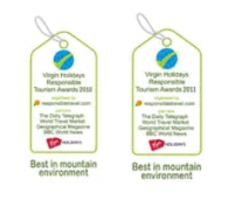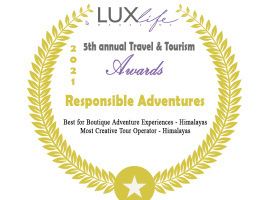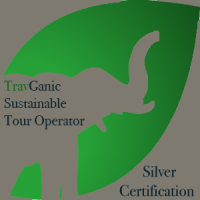Ladakh Is One Of The Few Regions For A Summer Himalayan Trek in India
Leh, the capital of Ladakh in Northern India, is only an hour’s flight away from Delhi. However, for the more adventurous and those who don’t suffer from motion sickness, you can opt for a bone-jarring 22-hour plus bus ride. The stunning scenery on this drive has to be done once in life! Ladakh means land of high mountain passes. The Buddhist monasteries, spectacular pastel-coloured deserts, jagged peaks, and colourful prayer flags flapping in the wind are Ladakh’s characteristics.
Although stark, Ladakh’s landscape is magically colourful. The summer is green in the valleys, with snowmelt streams feeding the green pastures and crop fields. Brilliant colours of the prayer flags flutter on the roofs of traditional whitewashed houses. The bright sun shines intensely throughout the year in Ladakh, making it sensible to use solar Para boilers to boil water or cook. It shares its borders with China and Pakistan. India has had wars with both, which makes Ladakh a militarily strategic area. It was opened for overland travel in 1974 when the tensions lessened with China. The local population and military presence stand about in equal numbers – 250,000 each. Once a Kingdom and an essential part of the Silk Route, Ladakh is now part of Jammu and Kashmir. The Ladakhis are an exciting mixture of Tibetan, Central Asian, and Indo-Aryan. It became part of Independent India in 1948.

Ladakh is one of the few areas in the Himalayas that sits in the rain shadow where the mighty mountains block the Indian sub-continent’s monsoon clouds from passing through. Ladakh is fast becoming a playground for the fans of the Himalayan Adventure holidays during the summer season. They do get “freak rainfalls” every few years. In 2010, she witnessed a catastrophic flash flood in which nearly 200 people were killed in Leh. You can walk on ancient paths through Buddhist villages with Tibetan architecture, which brings you back in time.
On the way to Leh Palace, you will encounter numerous Tibetan refugees selling prayer flags, turquoise, and coral jewellery alongside the Kashmiri merchants who offer pashminas and beautiful silk carpets.
The Leh Palace was a crumbling ruin until it was refurbished recently. With its sloping, buttressed walls and overhanging wooden balconies, the re-renovated Palaces stand majestically over Leh’s city. Carved lion heads guard the palace entrance, and the throne room is painted with tigers and Buddhist murals, maintaining its ancient grandeur.
Smiling locals will greet you with “Jullay” while strolling in the market/bazaar area. “Jullay” is Ladakh’s traditional greeting, which is used at all times of the day. It can mean – “Hello,” “Thank you,” and “Goodbye.” Most visitors to Leh visit Hemis Monastery, which is an hour’s drive south of Leh. Hemis is one of Ladakh’s most important monasteries, and on the ride back to Leh, most tourists stop to visit the Thiksey monastery. The Thiksey monastery sits on top of a hill with its whitewashed temples with magnificent paintings. One can walk from temple to temple with the scent of burning incense and butter lamps, and if you are there early in the morning or the evening, you might even hear the monks chanting. The main attraction of the Thiksey monastery is the two-story-high Maitreya Buddha statue.

Another popular acclimatization tour is the walkthrough fields lined with poplars and willow trees to the fortress and monastery at Shey, once the king’s summer palace.
The popularity of Ladakh’s natural beauty has increased the number of visitors from the West as a choice for summer trekking vacations. As a result, there is a growing number of hotels and guest houses in Leh. Ladakh’s popularity has grown tremendously with domestic tourists after a movie with Ladakh scenery became a super hit. Previously the tourist season used to be in July and August. However, India’s new economic boom has become an all-year destination.
Some treks we offer in Ladakh
The treks from Jingchen to the Markha Valley
The Zanskar Trek
The Sham trek also is known as Likir to Temisgam trek.
Check out our Trekking packages for Nepal, Bhutan, India, and Tibet.
















